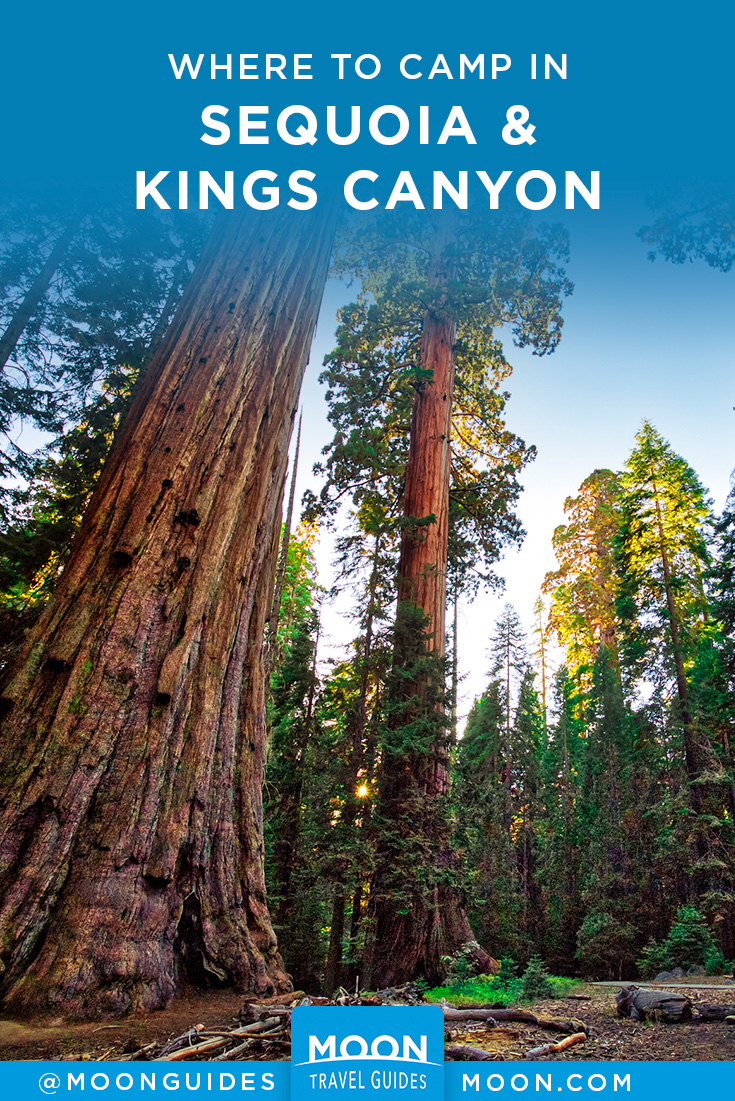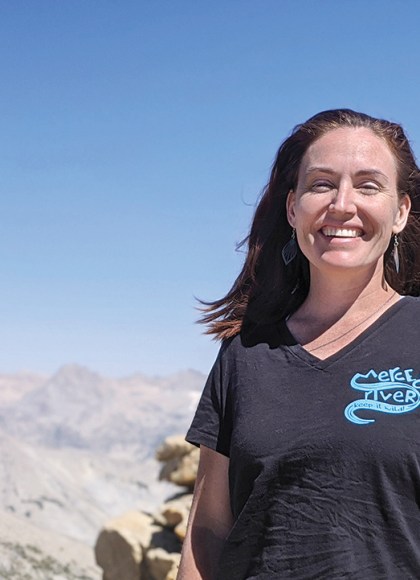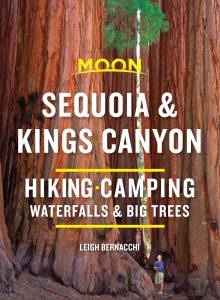Camping in and Around Sequoia and Kings Canyon
Whether you’re looking for the best place to pitch a tent for views of the night sky, RV campsites, or wheelchair-accessible options, here’s where to go camping in Sequoia and Kings Canyon National Parks.
Camping in the Foothills
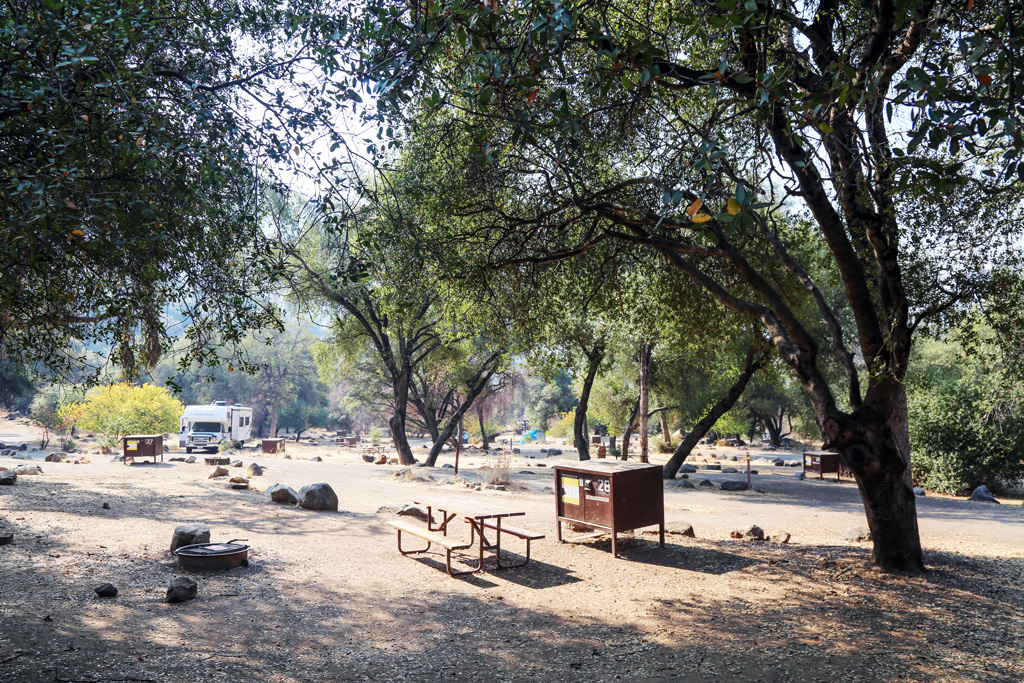
Campgrounds in the Park
Conditions for camping in the Foothills region are ideal thanks to the mild weather—even in the summer, as the nights usually cool off. There are no group campsites in this part of the park.
The Potwisha Campground (year-round, $22) is right on the Marble Fork of the Kaweah River and close to the confluence with the Middle Fork, offering the peaceful sounds of the river, a cool, down-canyon breeze, and a grove of trees. The 48 sites here are generally only available with an advance reservation; in winter, 38 of the sites are first-come, first-served. This is the only campground in the Foothills that’s open year-round and offers services. It’s also the closest to the Ash Mountain entrance. This is an ideal spot for hikers, fishers, and swimmers, thanks to features like food storage, flush toilets, a pay phone, and multiple nearby trailheads. Campsites 16, 18, 20 are the most beautiful and spacious, though some smaller tent sites on the upper loop are nice, too. There are pull-through sites for RVs, but no dump station. Ranger programs are offered here from July to September. The campground is about 4 miles (6 km) northeast of the Ash Mountain entrance, just off the Generals Highway.
Leave behind bustling Hospital Rock and turn down a narrow, curvy road for a riverside abode at Buckeye Flat Campground (Mar.-Oct., $22). Of the campground’s 28 tent-only sites, only one (site 20) is suitable for wheelchairs. Riverside sites are 13, 14, and 16-19. The best overall sites are 11 and 12. Picnic tables, fire rings, food storage, flush toilets, and drinking water are available. There’s no electricity. Day trippers and additional vehicles must park approximately a mile up the road. Peak season is April-September. All sites are available by reservation only.
If you’re looking for solitude—or if the other Foothills campgrounds are full, stay at South Fork Campground (year-round, no reservations, $6), a primitive campground with 10 tent-only, first-come, first-served sites. South Fork is a great base camp for hiking or backpacking the Ladybug Trail or along the South Fork of the Kaweah River. There’s no running water here, so bring your own. There are vault toilets. It’s a 13-mile (21-km) drive from Three Rivers via South Fork Drive. The road is rough and not recommended for low-clearance vehicles.
Campgrounds Outside the Park
On the shore of Lake Kaweah reservoir, Horse Creek Campground (37843 Sierra Dr., Lemon Cove, 559/597-2301, $20-40) provides boaters and fishers access to amenities like flush toilets, showers, and a dump station, but little shade or protection from scorching temperatures (100°F/38°C and above) and winds. Though tent camping is possible here, those in RVs will have more company and protection from the elements. The campground has 80 sites, available by reservation only, most of which have fire pits. Horse Creek is a 20-minute drive from the Ash Mountain entrance.
A grove of oaks hides the privately owned Kaweah Oaks Campground (42362 Sierra Dr., Three Rivers, 559/561-3602, $20) from the busy road. Book online to reserve one of the campground’s 13 walk-in, tent-only sites. Each site has a dirt pad and picnic table. No pets are allowed. There is a pit toilet, a shower, and electricity in the common area. Kaweah Oaks is about 5 miles (8 km) from the Ash Mountain entrance.
Camping in Giant Forest and Lodgepole
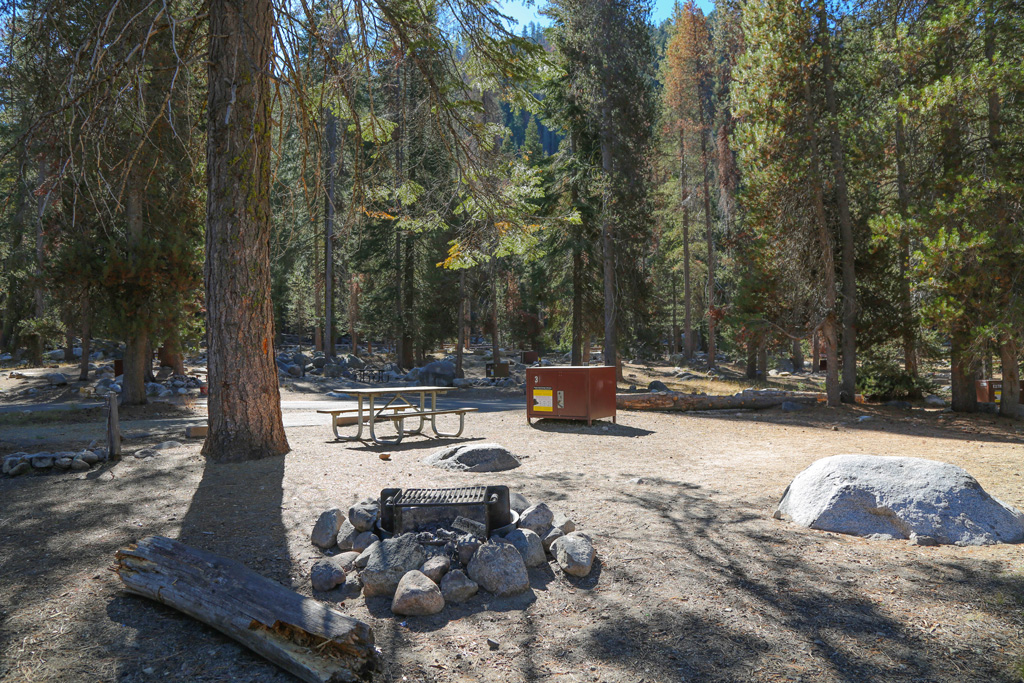
Campgrounds in the Park
Within view of the granite mountains above, Lodgepole Campground (Apr.-Nov., $22) provides the closest access to excellent hiking and creature comforts. With all 203 sites within earshot of the Marble Fork of the Kaweah River, the campground provides rest and relaxation with a perfect soundtrack. Conveniently, several hiking trails leave right from this area: Tokopah Falls, Twin Lakes, and Wuksachi Trail. It’s also walking distance to Lodgepole’s market, restaurant, laundry, showers, and shuttle. The campground has a dump station, flush toilets, and a pay phone. Be sure to store everything that smells in a bear locker and stay within arm’s distance of your food: Bears are very active in this area. For backpackers starting or ending trips, there are some walk-up sites available. Make a reservation early (starting in November of the previous year) because this campground is very popular.
Despite some tight quarters, uneven ground, disruptions by bears, early risers, and late night singers, Dorst Creek Campground (June-Sept., $22) is perfectly located for family or solo trips. Located 9 miles (14 km) from Lodgepole and 18 miles (29 km) from Grant Grove, the 212 sites of this midway point campground are often full because of its combination of landscape and amenities, which include flush toilets, water, fire pits, picnic tables, dump station, and a pay phone. Sometimes last-minute reservations can be found, and walk up sites are available on weekdays. The campground offers group sites for 15-50 people ($50-70) and wheelchair-accessible sites. It also provides access to Muir Grove and Dorst Creek Trails.
Campgrounds Outside the Park
Two campgrounds on national forest land offer over 70 sites and access to Lodgepole and Giant Forest, Grant Grove, and Hume Lake, all within 20 miles (32 km). Perhaps because of their proximity to good mountain biking, Big Baldy, and Jennie Lakes Wilderness, as well as easy access to the amenities at Stony Creek Lodge, both campgrounds are popular. Located half a mile east of Stony Creek Lodge on the Generals Highway, both campgrounds are open from late May through late September or early October, depending on weather. You may need a permit for your campfire or stove, so check fire restrictions before you arrive. Stony Creek Campground (Sequoia National Forest, 877/444-6777, late May-mid-Sept., $27, $7 for extra vehicle) has 50 sites with flush toilets and an amphitheater. Across the highway, a more rustic Upper Stony Creek Campground (Sequoia National Forest, 877/444-6777, late May-mid-Sept., $18, $5 for extra vehicle) has vault toilets and 23 RV and tent sites.
Unlike in the national park, which only allows camping in the backcountry or in campgrounds, dispersed camping is an option in the national forest. If you plan to have a fire, pick up a free permit at the visitors center in Grant Grove, at Hume Lake Ranger Station, or online at www.fs.usda.gov/sequoia. You’ll need to bring your own water and manage your waste properly.
Camping in Grant Grove
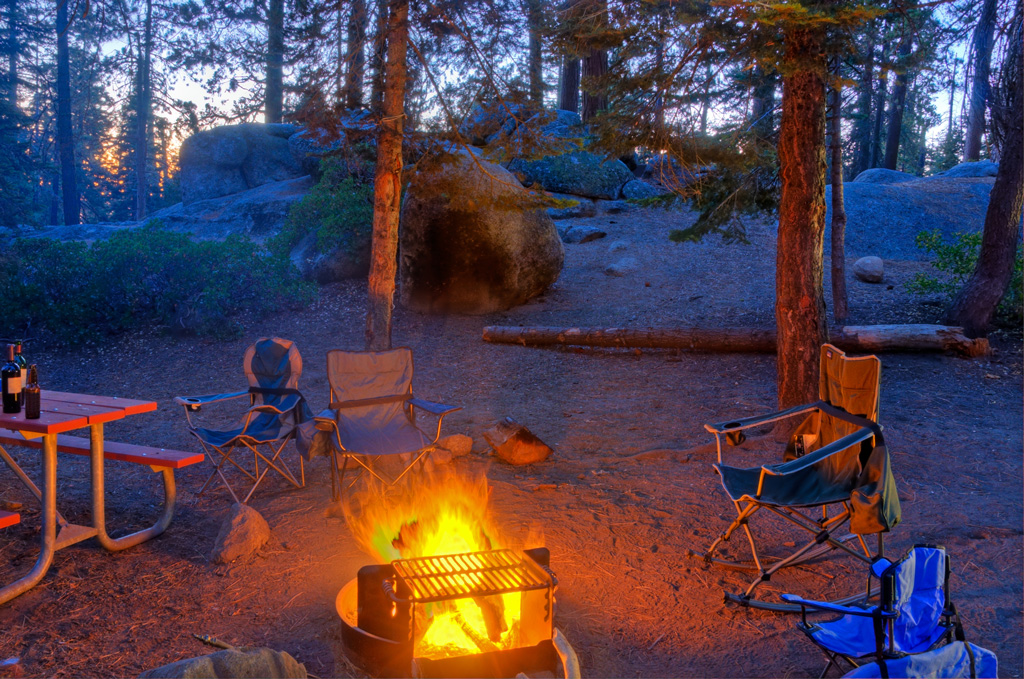
Each standard campsite in Grant Grove comes equipped with a grill over the fire ring and a picnic table with two benches. Usually there is a tent pad large enough for two tents and parking for one vehicle. RV sites are larger, but there are no electric or water hookups in the park. Dump stations are in Dorst Campground near Lodgepole or Princess Campground on the way to Hume Lake. Reservations are recommended, especially on summer weekends and holidays. Some walk-up sites are available at Landslide, Azalea, Crystal Springs, and Princess.
The best time to nab a spot is in the morning, ideally Monday through early Friday, before the majority of the crowds appear on Friday afternoons and Saturday mornings. Most campgrounds have bear boxes; store everything with a scent in these lockers. The bear boxes are big enough for a cooler, cooking gear, and snacks. Only burn dead and down wood for fires; do not bring in firewood from another place.
National park campsites have more amenities and generally are reservable online. Typically, national forest campsites require packing in toilet paper, sometimes water, and most cannot be reserved in advance. National forest sites sometimes provide an overflow option.
Campgrounds in the Park
In the heart of Grant Grove Village is the bustling but beautiful Crystal Springs Campground (mid-May-early Sept., $18), with 36 tent and RV sites. There are also 14 group sites (for 7-15 people, by reservation only, $40). Since the campground is conveniently close to the market and restaurant, you can pack light with just a tent and sleeping bag. Some of the sites offer more privacy than others. In summer, the sugar pines offer shade. It gets chilly in May and September. Group site F is wheelchair-accessible. Bear boxes, a fire ring, picnic tables, and potable water are available. Ranger programs are offered most summer evenings. There’s no dump station for RVs. Individual sites are first-come, first-served.
Azalea Campground (year-round, $18) is aptly named for the fragrant azaleas that bloom in summer. Best of all, this campground offers access to the General Grant Tree via a short trail. There are 110 first-come, first-served sites for tents and RVs. Sites along the western edge have the best views (60, 64, 65, 67, and 92). Site 30 is wheelchair-accessible. The campground has flush toilets and bear boxes. This is the only campground in the park that’s open during winter. Pets are allowed, but must be leashed.
Busy Sunset Campground (mid-May-early Sept., $22) is directly across from Kings Canyon Visitor Center, offering 157 tent and RV sites. This is a walkable campground, but not a peaceful one: Generators can be heard right up until quiet hours. Sites along the western edge of the campground (including 54, 80, 81, and 100) have the best views. A couple hike-in sites make for a more private experience. Sites 26 and 116 are wheelchair-accessible. Two large group sites (15-30 people, by reservation only, $50) are on a separate stem of the campground. There are flush toilets but no showers. Ranger programs are offered here during the summer.
Newsletter Signup
By clicking ‘Sign Up,’ I acknowledge that I have read and agree to Hachette Book Group’s Privacy Policy and Terms of Use
Campgrounds Outside the Park
Princess Campground (Sequoia National Forest, 877/444-6777, late May-early Sept., $27) offers 88 shaded spots, 19 of which are tent-only. Just off of Highway 180, near the junction of Hume Lake Road, this Forest Service campground makes up for the sounds of passing cars and lack of privacy with its location—nestled into a small pine grove beside a lush Sierra meadow. The sites on Shining Cloud Loop are the farthest from the road and have the least traffic noise. The campground has an amphitheater that hosts weekend campfire ranger talks. It also offers access to the Indian Basin interpretive trail and the Indian Basin Grove of giant sequoias. Drinking water and vault toilets are available. Princess also has a dump station for RVs ($7 usage fee). Most of the sites are only available with advance reservations. To get here from Grant Grove Village, drive 5.9 miles (9.5 km) on Highway 180 towards Hume Lake, then take a right into Princess Campground. If you get to the turn for Hume Lake you have gone too far.
Across the highway from Princess Campground is the biggest group site in Sequoia National Forest. Logger Flat Group Campground (Sequoia National Forest, 877/444-6777, mid-May-mid-Sept., $193) can accommodate 50 campers and 30 vehicles, including up to 10 RVs. There is drinking water and vault toilets, but no electric hookups.
At the national forest’s Stony Creek Campground (Sequoia National Forest, 877/444-6777, late May-mid-Sept., $27, $7 for extra vehicle) and Upper Stony Creek Campground (Sequoia National Forest, 877/444-6777, late May-mid-Sept., $18, $5 for extra vehicle), set along Stony Creek, there are firs and pines to hang your hammock on as you escape the heat of the Central Valley. The downsides are there’s some mosquitoes and not much privacy. Stony Creek offers 48 sites and flush toilets. (Sites 17-21 are the farthest from the road.) Upper Stony Creek has 18 sites and vault toilets. Amenities are available at nearby Stony Creek Lodge, including food and beverages. A day-use picnic area, nearby trails, and healthy forests full of twittering birds make these campsites perfect for nature lovers.
With 43 sites (15 of which are tent-only), the peaceful Big Meadow Campground (Sequoia National Forest, 877/444-6777, late May-late Sept., $23) is a jumping off point for exploring the Jennie Lakes Wilderness. There is ample shade, a picnic table, and a fire pit and ring at each site. The campground has vault toilets. Be sure to arrive while it’s still light out, as the sites are spread along Forest Road 14S11 and can be hard to find in the dark. If you need help, check in with the camp host at site 7. Bring your own water. To get here from the junction of Highways 180 and 198, take the Generals Highway for 6.9 miles (11 km), past Big Baldy trailhead, and turn left on Big Meadow Road or Forest Road 14S11 and continue for 2.8 miles (4.5 km).
Hume Lake Campground (Sequoia National Forest, 877/444-6777, late May-mid-Sept., $27-29) is within walking distance of the water and is one of just three campgrounds near Hume Lake. Sites 22-29 have lake views. The 64-site campground has drinking water, flush toilets, and a pay phone. There are laundry services and a gas station nearby.
On Forest Road 13S09, which connects Hume Lake to the Generals Highway, are two quaint campgrounds. The 11-site Tenmile Campground (Sequoia National Forest, 877/444-6777, late May-mid-Sept., $23) is small, quiet, and a 15-minute drive upstream and uphill from Hume Lake. Even smaller than Tenmile is the nine-site Landslide Campground (Sequoia National Forest, no reservations, late May-mid-Sept., $23). Landslide is about a mile northeast of Tenmile, along Forest Road 13S09. Bring your own water. Forest Road 13S09 can close due to weather conditions from late fall to early spring.
Dispersed camping is permitted in Sequoia National Forest (unless posted otherwise), but you will need a permit for any fire, open flame, or stove. Otherwise, you can nab a spot at one of the national forest campgrounds near Grant Grove, just miles from the park boundary. Heading towards Lodgepole on the Generals Highway (Hwy. 198), there are several campgrounds. This area is close to Big Baldy and Redwood Canyon.
Camping in Kings Canyon and Cedar Grove
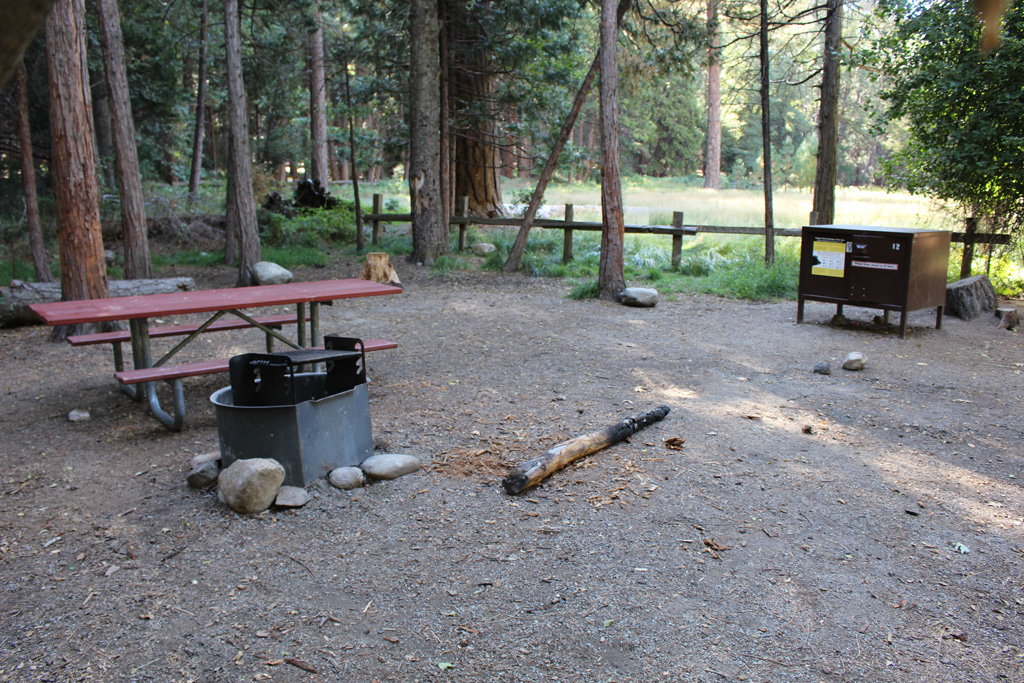
Campgrounds in the Park
All four of Cedar Grove’s campgrounds are fairly close together and within walking distance of the Kings River, as well as the market, restaurant, and visitors center. Sentinel is the most central and has the most ranger programs. A bike trail connects all of the campgrounds to Cedar Grove Village. All campgrounds have flush toilets and drinking water. Each site has a fire ring, a picnic table, a bear-proof food storage box, and a tent pad. The campgrounds are open from spring through fall.
There are no dump stations or RV hook-ups in Cedar Grove. For firewood, gather dead and down wood near your campsite or buy it at the market. Using bear boxes is crucial for protecting the wildlife.
Reservations are only possible at Sentinel and Canyon View. Canyon View only offers group sites. The sites at Sheep Creek and Moraine are available on a first-come, first-served basis.
Sentinel (spring-fall, $22) is the most popular campground. Its 82 sites are fully reservable online 6-12 months in advance. Sheep Creek (spring-fall, $18) is first-come, first-served and is the closest campground to the river. Its 111 sites have plenty of shade from pine trees. The 120 sites at Moraine (spring-fall, $18) are also first-come, first-served. This campground is well named for its position on one of the hillocks of unsorted sediment left behind by the glaciers. Canyon View (spring-fall, $30-60) only offers group sites. Its 16 sites are available by reservation for tent and car camping. No RVs or trailers are allowed. If you show up to Sheep Creek or Moraine when people are leaving (8am-11am), you’ll have plenty of options for getting the site of your choice.
Campgrounds Outside the Park
Convict Flat (877/444-6777, spring-fall, free) is a small campground in Sequoia National Forest, nestled under oak trees and within earshot of the Kings River. It has five sites with picnic tables. There is a vault toilet. Bring your own water. Large trailers won’t fit in most of the sites. This is a good spot for anglers, as it’s close to Redwood Creek, a tributary of the Kings River. This is also a good campground if you’re looking for solitude among the yucca blooms. Convict Flat opens in the spring when Highway 180 opens for the season. To get to the campground from Grant Grove, head northeast on Highway 180 for 18 miles (29 km). Stay to the right as you enter the campground; all five sites are on the right side of the road.
Dispersed camping is permitted in the Hume Lake Ranger District of Sequoia National Forest (unless posted otherwise), but you will need a permit for any fire, open flame, or stove. There are camping spots with existing fire rings along the Kings River and the road between Convict Flat and the park boundary at Lewis Creek. You will be able to hear noise from the road, but it’s a good balance of achieving solitude while still within a short distance of your car.
Camping in Mineral King
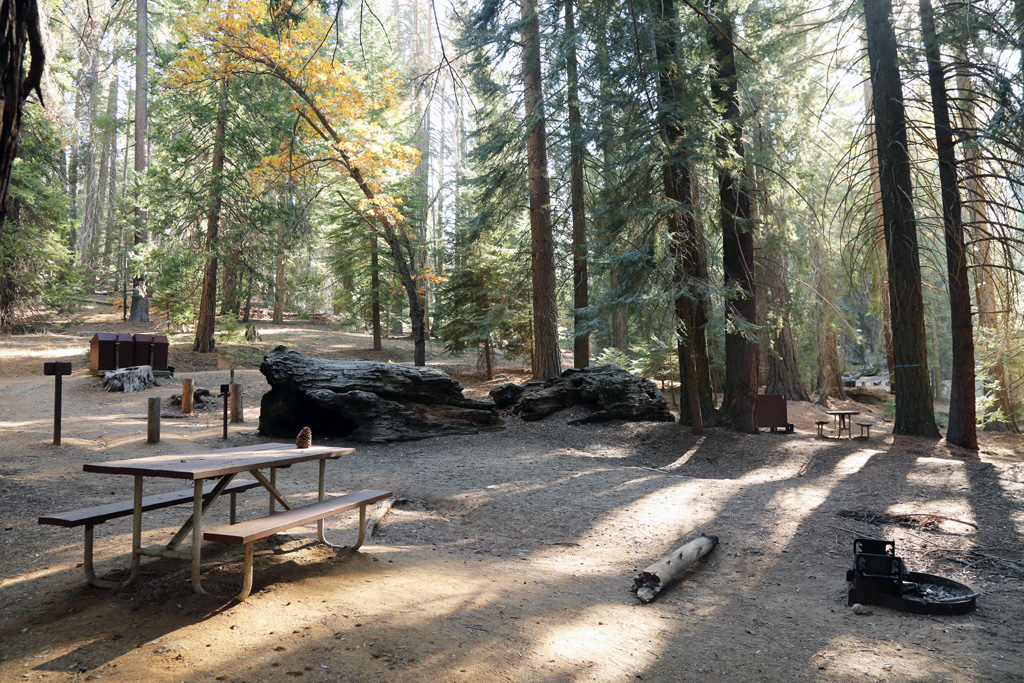
Mineral King is a tent camper’s paradise: serene and quiet. Whether you choose to pitch your tent at Atwell Mill or Cold Springs, you’ll be minutes from world-class hiking. Both sites have potable water, vault toilets, fire pits, picnic tables, food lockers, and pay phones. No RVs can make the trip into Mineral King, which means no generators will be whirring and echoing throughout the campgrounds. Pets are permitted on leash at both campgrounds. There are no reservations accepted for either campground; all sites are first-come, first-served. For holiday weekends, arrive early on Friday. You can self-register for a campsite at the entrance to Mineral King, Lookout Point. (Be sure to clip the ticket from your registration to the post at your driveway to show that your site is paid for and occupied.)
The only campground where you can sleep beneath the stars and the sequoias is Atwell Mill (mid-June-late Oct., $12). At 6,600 feet (2,010 m) of elevation and 6 miles (10 km) from the end of Mineral King Road, 21 sites sit in a forest of sequoias away from the winds of Mineral King Valley and nestled into a pocket of meadows. This is one of the quietest places to sleep in the front country. It also provides great access to the Hockett Trail (near campsite 16). Site 11 is a wheelchair-accessible site. Site 12 is tucked away and overlooks a meadow. The nearest supplies are 1.5 miles (2.5 km) away at Silver City Mountain Resort.
As you camp along a creek with great views of all of Mineral King’s majesty, you’ll feel luckier than a miner striking pay dirt. Cold Springs (May or June-late Oct., $12) is close to the Mineral King Ranger Station and offers access to fly-fishing in the East Fork of the Kaweah River. Choose from the 31 sites with drive-up access or the 9 walk-in sites, which are 100-200 yards from the parking area, and offer more privacy. This campground opens later than Atwell; the opening date is dependent on the snow levels. Some of the best sites are available by turning right after the bridge. The nearest supplies are 2.5 miles (4 km) away at Silver City Mountain Resort. From site 6, an easy, wildflower-filled nature trail offers views of the whole valley while following the river.
Newsletter Signup
By clicking ‘Sign Up,’ I acknowledge that I have read and agree to Hachette Book Group’s Privacy Policy and Terms of Use
Pin it for Later
